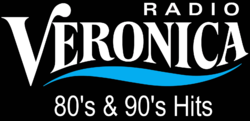Radio Veronica
|
|
|
|---|---|
| Radio station ( private ) | |
| reception | analog terrestrial , cable , satellite and web radio |
| Reception area | Netherlands |
| Start of transmission | October 15, 1959 |
| List of radio stations | |
Radio Veronica is a Dutch radio station that became known as a pirate station and today it broadcasts pop and rock music from the 1980s, 1990s and 2000s.
history
A group of Dutch radio dealers decided on October 15, 1959 in Amsterdam to found "Vrije Radio Omroep Nederland" (VRON) with the aim of broadcasting ad-financed radio programs based on the American and Danish models from the sea. Due to the legal situation in most European countries, such projects could only be carried out outside the sovereign territories ( three-mile zone ). The project name "Veronica" arose from the abbreviation of the company's name.
In order to get to potential advertisers as quickly as possible, the company member Henk Oswald sent a test program on November 15th, which he named "From the High Seas". In reality it was broadcasting from his office in the heart of Amsterdam. As early as December 9, 1959, the offshore radio company bought the discarded lightship Borkumriff for 63,000 guilders (hfl) in Emden in order to have it converted into a transmitter ship at the Cassens shipyard . On April 18, 1960, the radio ship left the port of Emden as a tug under the Panamanian flag to anchor in international waters near Katwijk off the Dutch coast.
Radio Veronica opened its broadcasting operations from See on April 21, 1960. From May 17, 1960 it broadcast on the medium wave frequency 192 meters (1562.5 kHz). Due to a lack of advertising contracts, the company ran into financial difficulties. In the same year the brothers Bull, Dirk and Jaap Verweij took over the management of the company and achieved an advertising boom for the station in a very short time. In the period from January 2 to March 22, 1961, the CNBC (Commercial Neutral Broadcasting Company) broadcast an additional program from on board the transmission ship.
On November 16, 1964, the former lightship Borkumriff was replaced as a transmitting ship by the former German herring logger Norderney . The popularity of the sea transmitter among the Dutch population increased. The country's radio control authority counted more than 5 million listeners in 1961. At that time, the kingdom had 13.5 million inhabitants. While mostly Dutch hit productions were played in the first few years, the station developed more and more into a pop music station from 1965 onwards, but did not fail to let domestic productions compete against “the rest of the world”. In the 1960s, the station's particular ambition was to be one of the first to play the new singles of the big bands, for example the Beatles or the Rolling Stones . This was done in the form that these songs were then broadcast about thirty times a day. The Veronica invention "Alarmschijf", which is used as a marker for a favorite preview, is still used in the Dutch charts to this day.
Despite the increasing pressure from the other countries bordering the North Sea to abolish the pirate channels, the Dutch government tolerated Radio Veronica after various demonstrations (the largest in 1973 in The Hague) had documented the listeners' will. After the Verweij brothers left the Veronica Society (through death and criminal machinations), a new management called Veronica Omroep Organizatie (VOO) was founded. The directors were former Veronica disc jockeys Rob Out and Lex Harding. After the amendment to the Dutch Broadcasting Act, the now illegal sea broadcaster Radio Veronica had to cease broadcasting on August 31, 1974.
In 1976 the company Veronica started as a legal broadcasting organization within the framework of the Dutch radio system and received airtime on the various radio and television stations of the Dutch publieke Omroep . Especially on the pop wave Hilversum 3 (later Radio 3, today 3FM ) Veronica caused a sensation with its Friday programs (“Volle Vrijdag”). In 1985, VOO achieved what is known as A status in the Dutch broadcasting system, making it one of the major broadcasting organizations that fill the broadcasting time on the public waves.
In 1995 VOO left the Dutch broadcasting system. The Veronica brand was taken over by the Holland Media Group (HMG). A commercial TV station was created under the name Veronica and the commercial medium-wave station “Holland FM”, which had been bobbing in front of it until then, was renamed “Hitradio Veronica”. From 1998 the station was continued under the name "Veronica FM" and broadcast on VHF. In 2000 the name was changed to "Yorin FM", as the Veronica Association left HMG (which HMG controlled) after a dispute with RTL and took the naming rights with them.
Veronica had disappeared from the Dutch airwaves from 2000 to 2003 until the Sky Radio Groep revived the brand in 2003 and with Radio Veronica - de best 80s en 90s hits on an almost nationwide FM station chain, a program with well-known DJs and new talents spread. Radio Veronica's market share in 2006 was around 5 percent. The Veronica-supporting association (Vereniging Veronica) has a 10% stake in the Sky Radio Groep. This, and thus Radio Veronica as well, is 85% controlled by the Telegraaf Media Groep.
gallery
See also
literature
- Johannes Ruhr: Musik von See , radio series, Radio Ostfriesland , 2003.





